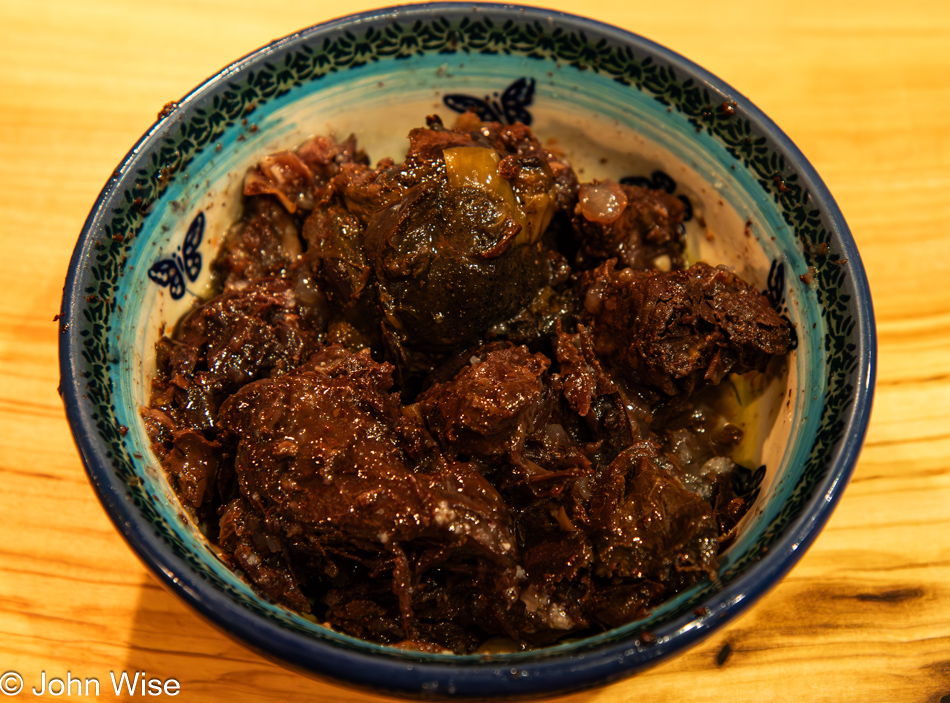
Earlier this summer, I wrote a post called Gas-Lighting and how the media’s attention to the inflationary price of gas and the consumer obsession with it is a red herring. Today, I’m going after the foggy shroud created around food and the supposed inflation people are suffering from in order to feed their families. Before I even work out the details of what Caroline and I spend on our luxury diet that one might perceive to be pricey, I’m going to say that it’s actually incredibly inexpensive.
Like everyone else, when I go shopping, I have some sense that I’m spending a lot of money on groceries as I pay the bill, and then there’s all the stuff I have to buy online because things like ပင္ပိ်ဳရြက္ႏု a.k.a. Burmese Crispy Mixed Beans are not available anywhere in the entire state of Arizona. Should you ask if there’s no substitute for ပင္ပိ်ဳရြက္ႏု, I’d have to beg for your understanding that without that a Burmese preserved ginger salad is just not authentic. Nor can I begin to accept the idea of an avocado and cherry tomato salad without my favorite Terre Bormane white vinegar at $20 per 16.9-ounce bottle from Amazon.
But then I go through the exercise of breaking down how I use ingredients and what they cost per portion. Two years ago, I examined the crazy price of my homemade dehydrated granola, which requires no less than three days to make after soaking, grinding, and drying for a couple of days. When my 10 pounds of raw organic almonds (yes, they are raw, almonds generally are pasteurized) from California after paying $100, it feels like those are some expensive nuts, as who spends $100 at a time on nuts? And you can bet I do the same for the eucalyptus honey, walnuts, flax seeds, pumpkin seeds, sunflower seeds, oat groats, and rolled oats that go into my morning meal. Well, it turned out that an entire 6-pound batch costs us about $45; again, who buys $45 of cereal at once? But that aside, my granola at forty-seven cents an ounce is costing us $1.88 a day. There’s also the matter of the eighty-five cents spent on soy milk per bowl of granola.
Unless we have eggs, which is what we do on the weekend. Take the four brown eggs, three slices of Kirkland bacon, one Vidalia onion, and a package of Chinese Chongqing Fuling Zhacai Preserved Mustard, and this hardly breaks the bank, costing a modest $2.81 each or $5.62 for the two of us to enjoy a homemade hot breakfast on the weekend.
Now, keep in mind that when we are eating breakfast at home, the most we typically spend, on average, is $2.76 per day. I’ll come back to this.
Lunch obviously gets more expensive, but not by much. Leftovers play a serious role in our lunchtime routine outside of the weekend when I can make something fresh for both of us. While there’s a gamut of meals, I’ll share two sides of the equation, one quick and easy, the other a lot more involved. On the one hand, it’s convenient for me to throw in a pre-cooked Angus burger from Costco, which sells by the dozen for $20.70 or $1.73 each. On top of this, I add an entire avocado that also comes from Costco, so $1.27 for that brings my lunch to $3.00. As for the peculiar lunch, being diabetic, I have to measure my options when it comes to carbohydrates.
The other lunch falls right out of the lap of luxury; it is called kimchi sundubu-jjigae, which is a Korean stew. The soup base I make in large batches and store in the freezer; it’s comprised of ground pork, onion, green onion, garlic, Korean chili powder called gochugaru, soy sauce, salt, avocado oil, and sesame oil. The rest of the ingredients include pork jowl, Korean dried green veggie (aster scaber is our favorite), shiitake mushrooms (preferably fresh), kimchi, extra soft Korean tofu, and a drizzle of sesame oil, sometimes a raw egg too. The cost of sundubu ends up being $14.00 or $4.66 a portion, as it’s inevitable that we have leftovers that Caroline gladly takes to work.
In order to come to an average cost of lunch, we’ll have to work through some of our evening meals as they fill in for lunch on many days.
Obviously, dinner is going to be a pricey affair but then again, not. As with our other two meals of the day, there is some diversity when it comes to our final meal of the day, too. Trying on occasion to keep things healthy, we are not beyond incorporating a couple of vegetarian options each week, such as kadhai paneer, which is Indian cheese with bell pepper, Roma tomatoes, and a few fenugreek leaves, served on our brown rice/quinoa mixture. Then there’s our obsession with beans, almost always from dry beans. We are comfortable buying Peruano/mayocoba beans from a local discounter for as little as $1.85 per pound or purple ayocotes that ring in at close to $9.00 per pound. Both crockpot dishes make at least four portions; we’ll go with 4 for ease of calculation. The cheaper dish with the Peruanos, an onion, six slices of bacon, and a quart of chicken stock costs about $8.00 or $2.00 per portion. The pricier ayocotes with onion, crushed San Marzano tomatoes, 1/2 a roast Costco chicken, a 4-ounce can of green chilies, and chicken stock come in at nearly $19.00 or $4.75 per portion. Mind you, it’s more common that a crock of beans will supply us with at least four dinner portions and 1 or 2 lunch containers for Caroline to take to work.
We are certainly meat eaters, and while we try to balance our expenditures there, the fish we order online from Canada costs us between $10 and $19 a portion. I can buy pork chops from Costco that end up costing only $2.30 a chop, but we also keep a supply of Mangalitsa pork chops on hand that, while considerably thicker than Costco’s, are $16.50 each, which in turn make the prime filets that cost $13.00 per 6-ounce portion seem almost cheap. Then, for a further example of our diet, we’ll fix pasta maybe once a month (I’m diabetic, so there’s a reason our diet is light on carbs). My goto pasta starts with red lentil/quinoa fusilli, Rao’s Arrabiata sauce, a can of corn, 1.3 pounds ground beef, an onion, and a handful of capers, which adds up to about $20 for a solid four portions or $5.00 per person.
Rounding our average meal costs up for breakfast to $3 per person per day, lunch of $5, and dinner of $8.00 brings us to the extravagant gourmet eaters spending between $800 and almost $1,000 a month on food. Mind you that over 90% or more of our ingredients are not processed; they are raw ingredients, often organic. With the international ingredients and online meat and fish, we spend an inordinate amount on those items.
Just remove the pricey meat and fish options, replacing them with meat and fish from any regular grocery store, and our average dinner costs drop down to only $4.40 per person, while lunch comes in at $4.13. Now, with breakfast at $2.76, lunch, and dinner, our daily costs are only $11.27 per day per person or $676 per month.
Of course, there’s the issue of time to shop, prepare, and clean up these homemade, healthy meals, and while we have the luxury of one of us having that time and the inclination to accept that to eat well, there’s a cost that comes with that. The alternative is what? Egg and bacon burrito at a drive-thru joint for $8.00, spicy chicken combo at Chick-fil-A for $7, and a couple of pasta dishes at a nearby Italian place for $50 for the two of us? We would easily be spending between $80 and $100 a day for the two of us doing that. So, if we ate like that just twice a week, we’d spend an additional $640 minimum on top of whatever we made at home, which would still cost about $500 a month for the two of us.
The price of convenience is contributing to poor health, use of income, and family time, while the perception and constant lament about rising prices delude people into thinking they can’t afford to eat at home while the purveyors of this refrain of madness continue to profit.
The restaurant industry rakes in just under $900 billion a year, while the grocery industry earns just over $810 billion, a nearly $100 billion difference. Funny, we hear about the billionaires minted out of Walmart, but we hear nothing about the extraordinary wealth being taken from preparing junk food for Americans.





